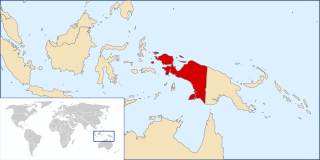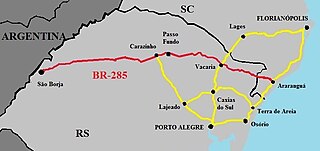Related Research Articles

Papua New Guinea, officially the Independent State of Papua New Guinea, is a country in Oceania that comprises the eastern half of the island of New Guinea and its offshore islands in Melanesia. Its capital, located along its southeastern coast, is Port Moresby. The country is the world's third largest island country, with an area of 462,840 km2 (178,700 sq mi).

Melanesia is a subregion of Oceania in the southwestern Pacific Ocean. It extends from New Guinea in the west to the Fiji Islands in the east, and includes the Arafura Sea.

West Papua, formerly Irian Jaya Barat, is a province of Indonesia. It covers the two western peninsulas of the island of New Guinea, the eastern half of the Bird's Head Peninsula and the Bomberai Peninsula, along with nearby smaller islands. The province is bordered to the north by the Pacific Ocean, to the west by the Halmahera Sea and the Ceram Sea, to the south by the Banda Sea, and to the east by the province of Central Papua and the Cenderawasih Bay. Manokwari is the province's capital and largest city. West Papua is the second-least populous province in Indonesia. It had a population of 1,134,068 at the 2020 Census, and the official estimate for mid 2021 was 1,156,840. However the total area and population will be reduced by the Parliamentary decision on 17 November 2022 to create a 38th province of Indonesia, comprising Sorong city and the regencies of Sorong, South Sorong, Raja Ampat, Maybrat and Tambrauw. The reduced West Papua Province will thus have a mid-2021 population estimated at only 551,791.

The indigenous peoples of West Papua in Indonesia and Papua New Guinea, commonly called Papuans, are Melanesians. There is genetic evidence for two major historical lineages in New Guinea and neighboring islands: a first wave from the Malay Archipelago perhaps 50,000 years ago when New Guinea and Australia were a single landmass called Sahul and, much later, a wave of Austronesian people from the north who introduced Austronesian languages and pigs about 3,500 years ago. They also left a small but significant genetic trace in many coastal Papuan peoples.

Western New Guinea, also known as Papua, Indonesian New Guinea, or Indonesian Papua, is the western Indonesian half of the island of New Guinea. Since the island is alternatively named as Papua, the region is also called West Papua.
Serbian hip hop refers to all genres of hip hop music in the Serbian language. The term is also sometimes used to refer to any hip hop music made by Serbs, including instrumental hip hop, as well as rap songs by members of the Serbian diaspora, often in languages other than Serbian. Some of most prominent hip hop groups include VIP, Sunshine, p.pop Beogradski Sindikat, Bad Copy. Popular solo artists include Juice, Gru, Struka, Ajs Nigrutin, Marčelo, Zli Toni, Fox, Surreal, Furio Djunta, Demonio.

Bad Copy are a hip-hop trio group from Belgrade, Serbia known for their humorous lyrics and slang. The members are Ajs Nigrutin, Wikluh Sky and Timbe. Miki Boj, born Milan Šaponja, was active in the band until his death 1999. They have released several albums as a group and as solo artists and helped the popularization of hip hop music in Serbia and Ex-Yugoslavia in the new millennium.
Içara is a city in the Brazilian state of Santa Catarina. It is located 170 km south of Florianópolis, the state capital and around 890 km south of São Paulo. It is the Brazilian capital of the honey and tobacco industries, but is also very strong in plastic, ceramic tiles and chemicals.
The Huon languages are a language family, spoken on the Huon Peninsula of Papua New Guinea, that was classified within the original Trans–New Guinea (TNG) proposal, and William A. Foley considers their TNG identity to be established. They share with the Finisterre languages a small closed class of verbs taking pronominal object prefixes some of which are cognate across both families, strong morphological evidence that they are related.

New Guinea is the world's second-largest island with an area of 785,753 km2 (303,381 sq mi). Located in Oceania in the southwestern Pacific Ocean, the island is separated from Australia by the 150-kilometre wide Torres Strait, though both landmasses lie on the same continental shelf. Numerous smaller islands are located to the west and east. The eastern half of the island is the major land mass of the independent state of Papua New Guinea. The western half, known as Western New Guinea, forms a part of Indonesia and is organized as the provinces of Papua, Central Papua, Highland Papua, South Papua, Southwest Papua, and West Papua. The largest cities on the island are Jayapura and Port Moresby.
The Papua conflict is an ongoing conflict in Western New Guinea between Indonesia and the Free Papua Movement. Subsequent to the withdrawal of the Dutch administration from the Netherlands New Guinea in 1962 and implementation of Indonesian administration in 1963, the Free Papua Movement has conducted a low-intensity guerrilla war against Indonesia through the targeting of its military, police, and civilian populations.
Timbé is a town in central Ivory Coast. It is a sub-prefecture of Katiola Department in Hambol Region, Vallée du Bandama District.
Timbé do Sul is a municipality in the state of Santa Catarina in the South region of Brazil.
Kabwum District is a district of the Morobe Province of Papua New Guinea. Its capital is Kabwum. The population of the district was 43,472 at the 2010 census. It is one of the mountainous places in Papua New Guinea. It is made up of four local level governments (LLGs) namely Komba, Selepet, Timbe or Deyamos and Yus. It shares its borders with the following districts of Morobe namely Finchhafen, Nawaeb and Tewai-Siassi. It also shares its border with Raicoast District of Madang Province. There are no direct road link from Lae City, the Provincial Capital to Kabwum District. So the way to get there from Lae is either by small planes or by ship and speed boat. If you choose to arrive by a plane then it will drop you directly at one of the local air-strips in the district. But if you choose ship or speed boats, then they will drop at Wasu where there is a highway road called Kabwum Highway linked to the mountainous part of the District. From there you can choose one of the local PMV to take you to your destiny.
The Tembé, also Timbé and Tenetehara, are an indigenous people of Brazil, living along the Maranhão and Gurupi Rivers, in the state of Amazonas and Pará. Their lands have been encroached and settled by farmers and loggers, who do so illegally, and the Tembé are working to expel the intruders from their territories.
Ayub Timbe Masika is a Kenyan professional footballer who currently plays as a winger or a forward for Kenya national team.
Paul Reynolds Thurmond is an American politician from the state of South Carolina. A member of the Republican Party, Thurmond is a former member of the South Carolina Senate. He is the youngest child of Strom Thurmond, who served in the United States Senate for 48 years.

BR-285 is an east-west Brazilian federal highway that starts in Araranguá, Santa Catarina, and crosses the Gaucho range and highlands. It stretches approximately 674.5 km, passing through cities such as Vacaria, Lagoa Vermelha, Passo Fundo, Carazinho, Ijuí e São Luiz Gonzaga, and ends in São Borja, Rio Grande do Sul, on the border of Argentina.
Timbe may refer to:
This article describes the squads for the 2000 African Women's Championship.
References
- ↑ Timbe at Ethnologue (18th ed., 2015) (subscription required)